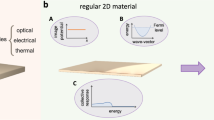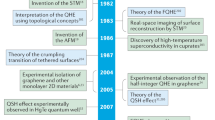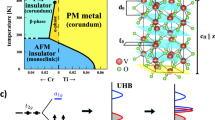Abstract
Insulators and conductors with periodic structures can be readily distinguished, because they have different band structures, but the differences between insulators and conductors with random structures are more subtle1,2. In 1958, Anderson provided a straightforward criterion for distinguishing between random insulators and conductors, based on the ‘diffusion’ distance ζ for electrons at 0 K (ref. 3). Insulators have a finite ζ, but conductors have an infinite ζ. Aided by a scaling argument, this concept can explain many phenomena in disordered electronic systems, such as the fact that the electrical resistivity of ‘dirty’ metals always increases as the temperature approaches 0 K (refs 4–6). Further verification for this model has come from experiments that measure how the properties of macroscopic samples vary with changes in temperature, pressure, impurity concentration and applied magnetic field4,5, but, surprisingly, there have been no attempts to engineer a metal–insulator transition by making the sample size less than or more than ζ. Here, we report such an engineered transition using six different thin-film systems: two are glasses that contain dispersed platinum atoms, and four are single crystals of perovskite that contain minor conducting components. With a sample size comparable to ζ, transitions can be triggered by using an electric field or ultraviolet radiation to tune ζ through the injection and extraction of electrons. It would seem possible to take advantage of this nanometallicity in applications.
This is a preview of subscription content, access via your institution
Access options
Subscribe to this journal
Receive 12 print issues and online access
$259.00 per year
only $21.58 per issue
Buy this article
- Purchase on Springer Link
- Instant access to full article PDF
Prices may be subject to local taxes which are calculated during checkout





Similar content being viewed by others
References
Mott, N. F. & Davis, E. Electronic Processes in Non-Crystalline Materials 2nd edn (Clarendon, 1979).
Mott, N. F. Electrons in disordered structures. Adv. Phys. 16, 49–144 (1967).
Anderson, P. W. Absence of diffusion in certain random lattices. Phys. Rev. 109, 1492–1507 (1958).
Dynes, R. C. & Lee, P. A. Localization, interactions, and the metal–insulator transition. Science 233, 355–360 (1984).
Lee, P. A. & Ramakrishnan, T. V. Disordered electronic systems. Rev. Mod. Phys. 57, 287–337 (1985).
Shklovskii, B. I. & Efros, A. L. Electronic Properties of Doped Semiconductors (Springer, 1984).
Ghosh, S. K. & Pal, T. Interparticle coupling effect on the surface plasmon resonance of gold nanoparticles: from theory to applications. Chem. Rev. 107, 4797–4862 (2007).
Gravais, F. Optical conductivity of oxides. Mater. Sci. Eng. R39, 29–92 (2002).
Waser, R., Dittmann, R., Staikov, G. & Szot, K. Redox-based resistive switching memories—nanoionic mechanisms, prospects, and challenges. Adv. Mater. 21, 2632–2663 (2009).
Szot, K., Speier, W., Bihlmayer, G. & Waser, R. Switching the electrical resistance of individual dislocations in single-crystalline SrTiO3 . Nature Mater. 5, 312–320 (2006).
Snider, G. S., Stewart, D. R. & Williams, R. S. The missing memristor found. Nature 431, 80–83 (2008).
Rossel, C., Meijer, G. I., Bremaud, D. & Widmer, D. Electrical current distribution across a metal–insulator–metal structure during bistable switching. J. Appl. Phys. 90, 2892–2898 (2001).
Sawa, A., Fujii, T., Kawasaki, M. & Tokura, Y. Hysteretic current–voltage characteristics and resistance switching at a rectifying Ti/Pr0.7Ca0.3MnO3 interface. Appl. Phys. Lett. 85, 4073–4075 (2004).
Kwon, D-H. et al. Atomic structure of conducting nanofilaments in TiO2 resistive switching memory. Nature Nanotech. 5, 148–153 (2010).
Wu, J. & McCreery, R. L. Solid-state electrochemistry in molecule/TiO2 molecular heterojunctions as the basis of the TiO2 ‘memristor’. J. Electrochem. Soc. 156, P29–P37 (2009).
Liu, C-Y. & Hsu, J-M. Effect of ultraviolet illumination on resistive switching properties of CuxO thin film. Jpn J. Appl. Phys. 49, 084202 (2010).
Kim, S. G., Wang, Y-D. & Chen, I-W. Strain relaxation in buried SrRuO3 layer in (Ca1- xSrx)(Zr1- xRux)O3/SrRuO3/SrTiO3 system. Appl. Phys. Lett. 89, 031905 (2006).
Wang, Y-D., Kim, S. G. & Chen, I-W. Strain relaxation in tensile and compressive oxide thin films, Acta Materialia 56, 5312–5321 (2008).
Mamchik, A. & Chen, I-W. Magnetic impurities in conducting oxides: I. (Sr1- xLax)(Ru1- xFex)O3 system. Phys. Rev. B 70, 104409 (2004).
Allen, P. B. et al. Transport properties, thermodynamic properties, and electronic structure of SrRuO3 . Phys. Rev. B 53, 4393–4398 (1996).
Lenzling, M. & Snow, E-H. Fowler–Nordheim tunneling into thermally grown SiO2 . J. Appl. Phys. 40, 278–283 (1969).
Sheng, P. Fluctuation-induced tunneling conduction in disordered materials. Phys. Rev. B 21, 2180–2195 (1980).
Menon, R., Yoon, C. O., Moses, D., Heeger, A. J. & Cao, Y. Transport in polyaniline near the critical regime of the metal–insulator transition. Phys. Rev. B 48, 17685–17694 (1993).
Ohta, H. et al. Giant thermoelectric Seebeck coefficient of two-dimensional electron gas in SrTiO3 . Nature Mater. 6, 129–134 (2007).
Ozbay, E. Merging photonics and electrons at nanoscale dimensions. Science 311, 189–193 (2006).
Engheta, N. Circuits with light at nanoscales: optical nanocircuits inspired by metamaterials. Science 317, 1698–1702 (2007).
Bagley, B. G. & Turnbull, D. The preparation and crystallization behaviour of amorphous nickel–phosphorus thin films. Acta Metallurgica 18, 857–862 (1970).
Acknowledgements
This work was supported by the National Science Foundation (grant nos DMR-05-20020, 07-05054 and 09-07523). For the TEM analysis, we are grateful to K.C. Hsieh and Y. Lu at the Frederick Seitz Materials Research Laboratory (University of Illinois), partially supported by the US Department of Energy (grants DE-FG02-07ER46453 and DE-FG02-07ER46471).
Author information
Authors and Affiliations
Contributions
I-W.C. conceived and designed the experiments and wrote the paper. A.B.C. performed the SiO2:Pt and SiN:Pt experiments. S.G.K. and Y.D.W. performed the perovskite experiments. W.S.T. performed the optical experiments. All authors analysed the data, discussed the results and commented on the manuscript.
Corresponding author
Ethics declarations
Competing interests
The authors declare no competing financial interests.
Supplementary information
Supplementary information
Supplementary information (PDF 1273 kb)
Rights and permissions
About this article
Cite this article
Chen, A., Kim, S., Wang, Y. et al. A size-dependent nanoscale metal–insulator transition in random materials. Nature Nanotech 6, 237–241 (2011). https://doi.org/10.1038/nnano.2011.21
Received:
Accepted:
Published:
Issue Date:
DOI: https://doi.org/10.1038/nnano.2011.21
This article is cited by
-
Electrodes: the real performers in single-barrier ferroelectric tunnel junctions
Applied Physics A (2023)
-
Silicon memristors go electric
Nature Electronics (2019)
-
An electronic silicon-based memristor with a high switching uniformity
Nature Electronics (2019)
-
Probing memristive switching in nanoionic devices
Nature Electronics (2018)
-
Interface-type resistive switching in perovskite materials
Journal of Electroceramics (2017)



